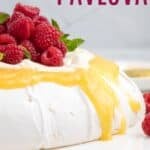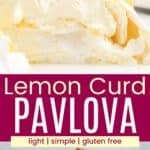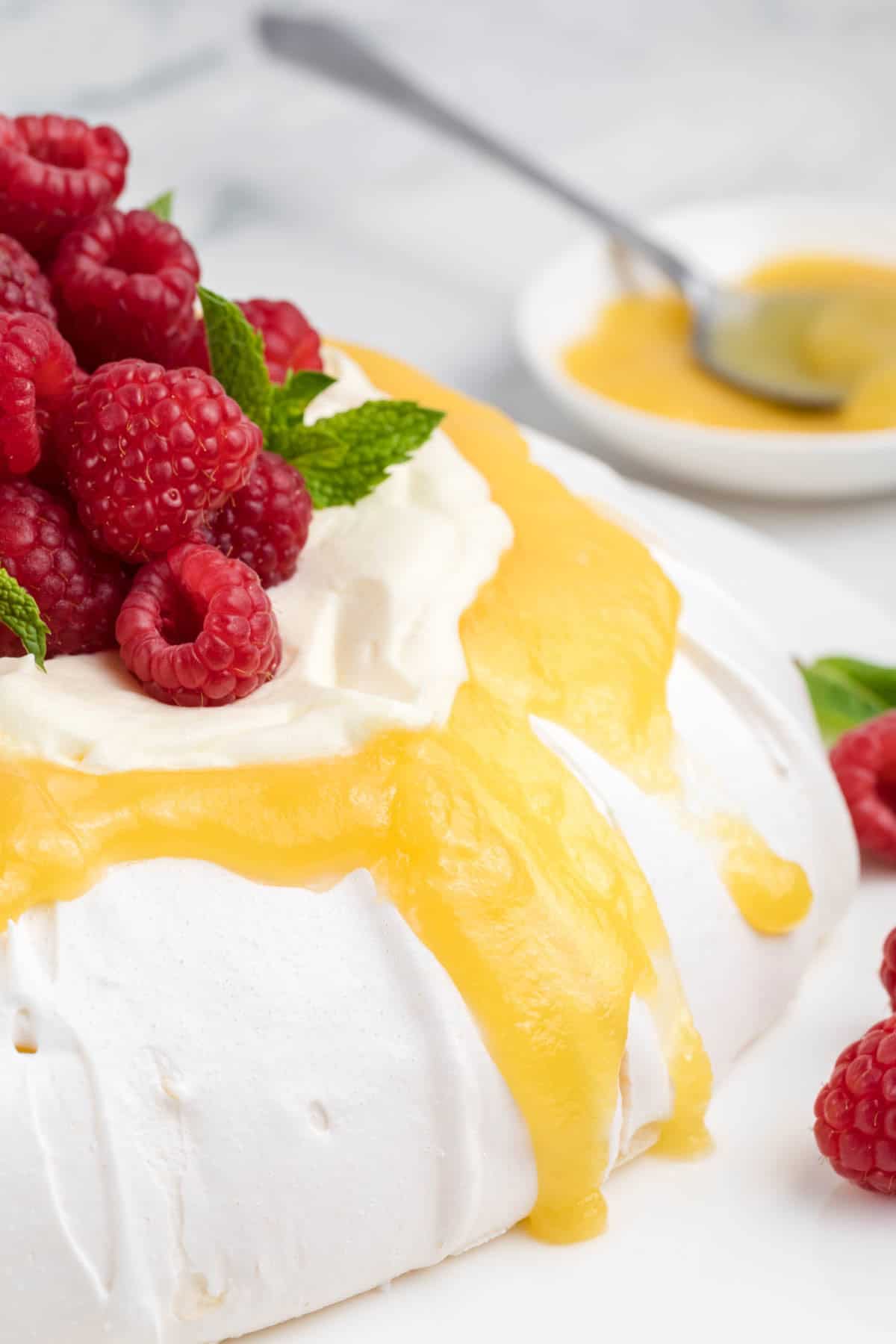This post may contain affiliate links. Read my disclosure policy.
This easy Lemon Curd Pavlova is a showstopping dessert with a crisp meringue shell and marshmallow-soft center, topped with tangy lemon curd, fluffy whipped cream, and fresh raspberries. Naturally gluten-free and ideal for spring or summer gatherings, it’s simpler than you’d think and full of bright, fresh flavor.
Delicious Details
- Cuisine Inspiration: Australian
- Primary Cooking Method: Oven
- Dietary Info: Gluten-free, Dairy-free option
- Skill Level: Easy
Why You’ll Love This Pavlova Recipe
If you haven’t made a pavlova recipe before, you’re in for a treat! My easy version of this beautifully textured dish—it turns out somewhere between a marshmallow and a meringue—is finished with a creamy pile of lemon curd, homemade whipped cream, and juicy fresh raspberries.
Unlike some recipes, my pavlova is not complicated and needs simple ingredients to make. I’ve included lots of tips in this post so that you can be assured it will turn out perfectly, too. Use your egg yolks to make my Lemon Curd Recipe, which handily works as a topping for the finished pavlova! (It’s also lovely topped with Vanilla Pastry Cream, also made with egg yolks). Here’s why you’ll love this recipe:
- Gorgeous texture. Love marshmallows? You’ll be sure to love a homemade pavlova, which magically creates a marshmallow-like interior with a lightly crunchy exterior.
- Easier than you’d expect. Follow my tips below to help you make this pavlova perfectly. I’ll take away any worry you might have about working with egg whites and meringe, I promise.
- Any toppings work. I love fresh seasonal berries with pavlova, but you can serve it all year round! Try different toppings like chocolate sauce or pastry cream instead of the lemon curd, or serve it just with whipped cream and a dusting of powdered sugar.
- It’s gluten-free! Yes, all of the ingredients in pavlova are gluten-free, making it an ideal choice when you want to serve a dish that everyone can eat.
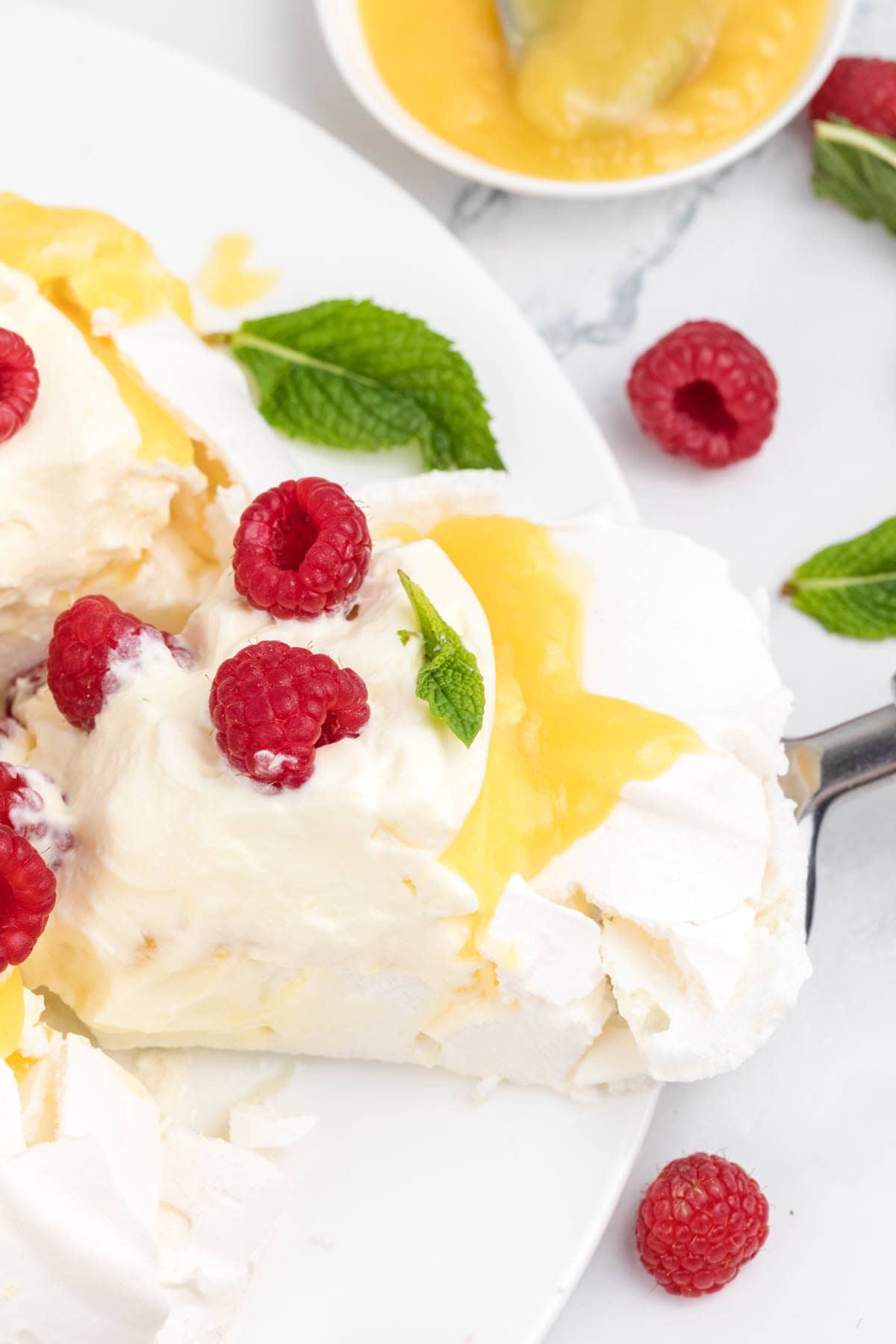
What You’ll Need
Here’s a look at what you’ll need to make this recipe. I’ve included the full ingredient amounts in the recipe card lower down.
- Egg Whites: I use whites from large eggs, brought to room temperature. Save the egg yolks if you want to make lemon curd or vanilla pastry cream.
- Granulated Sugar: Regular sugar works fine, or you can use superfine sugar or grind your sugar in a food processor to make it finer so it dissolves quickly into the egg whites.
- Cornstarch: Gluten-free cornstarch works as a stabilizing agent for the meringue.
- Vinegar: Use white vinegar along with the cornstarch to help the meringue hold its shape and structure.
- Vanilla Extract
- Toppings: Homemade whipped cream (heavy cream and powdered sugar), lemon curd, raspberries, and mint leaves.
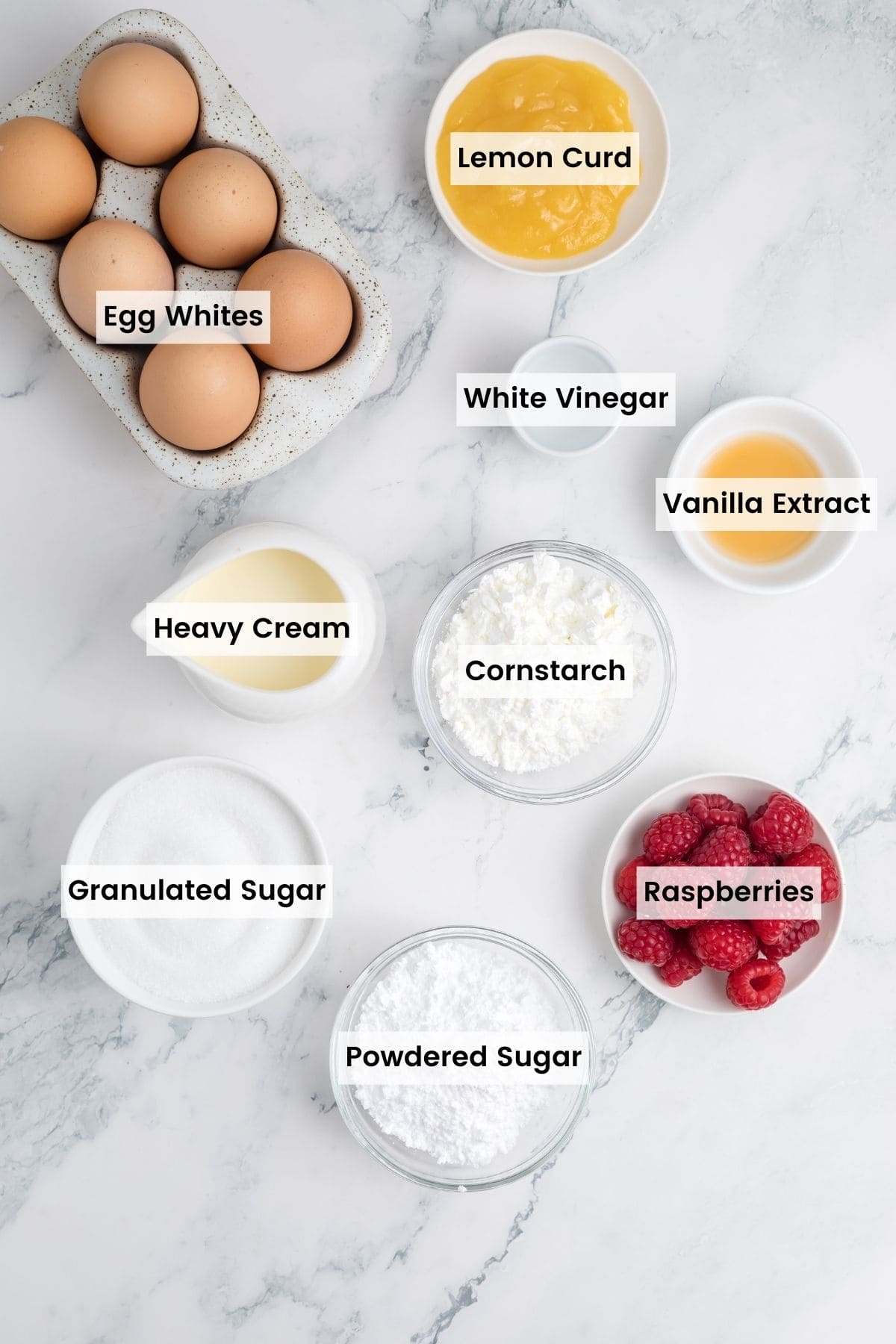
How to Make Pavlova
Let your egg whites come to room temperature before starting to whip them to help them get super light and fluffy. Then follow along with the photos below to guide you through making this recipe. I’ve included the detailed instructions in the recipe card towards the bottom of the post.
- Whip the whites. Beat the egg whites on medium-high speed until soft peaks form.
- Add sugar and vanilla. Slowly add in the sugar 1 tablespoon at a time, beating until the meringue is thick and glossy. Then beat in the cornstarch, white vinegar, and vanilla extract.
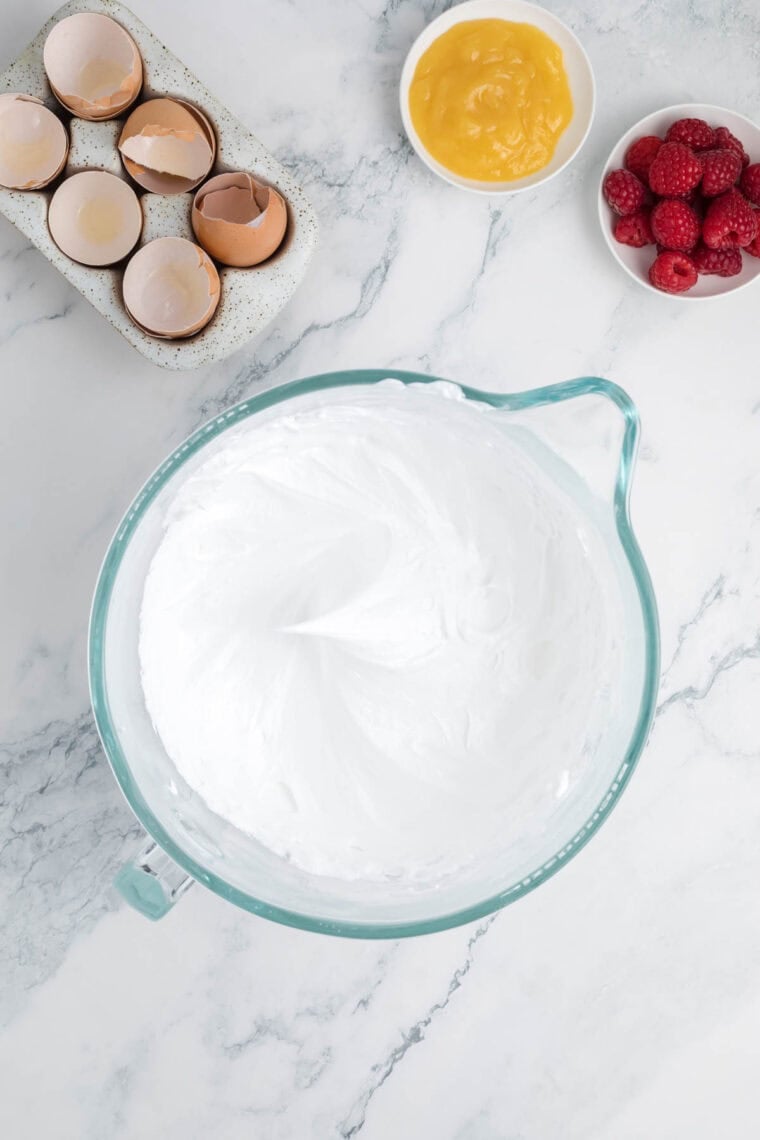
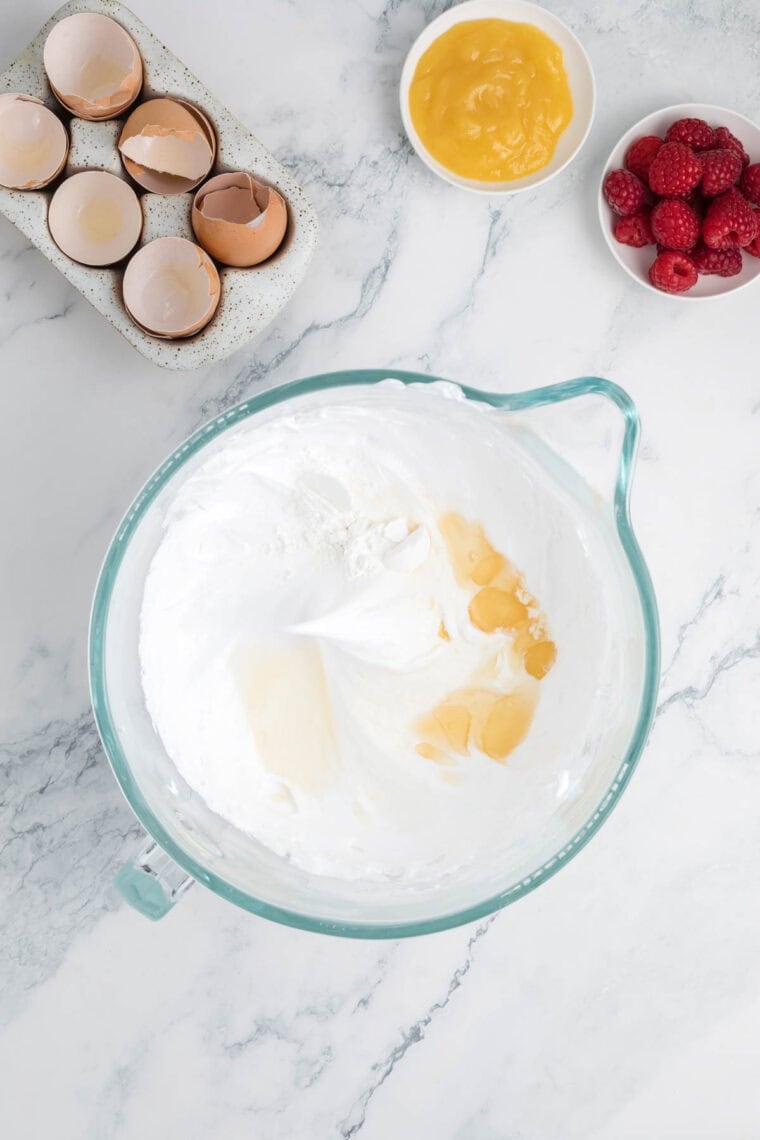
- Bake. Place the meringue on a lined baking sheet and bake it at 250°F for 1 1/2 hours, then turn off the oven and let it cool fully in the oven.
- Make whipped cream. Whip the heavy cream with the powdered sugar.
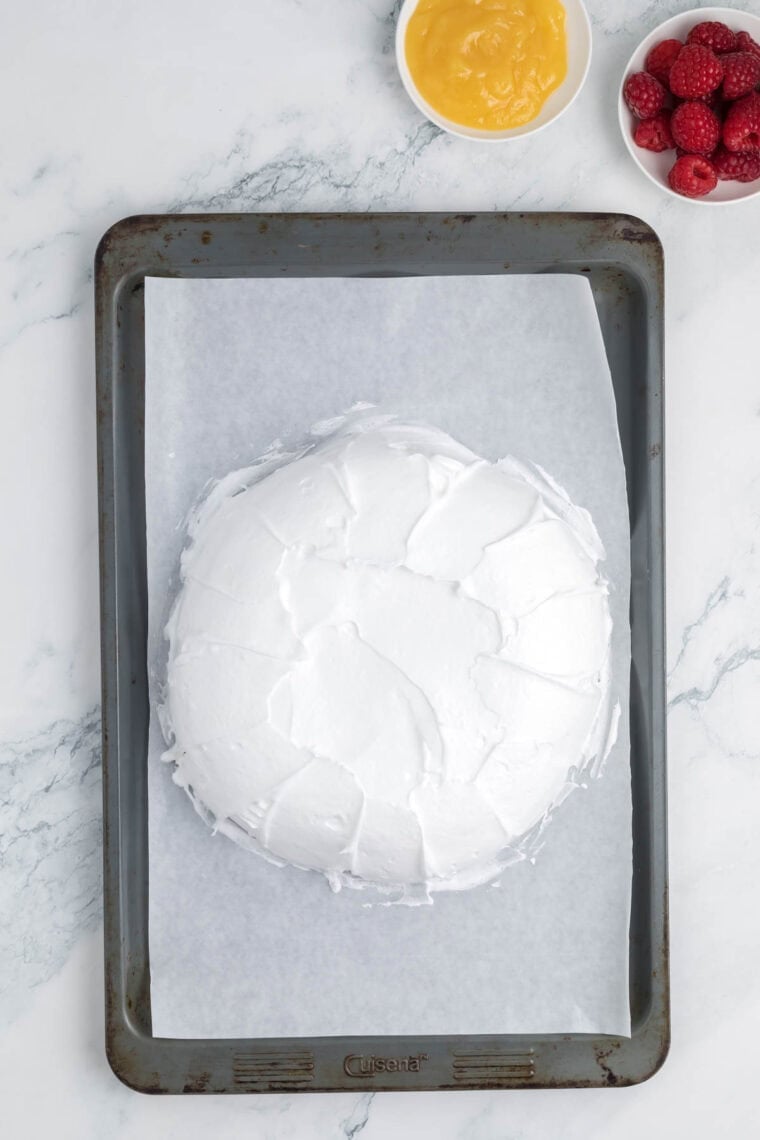
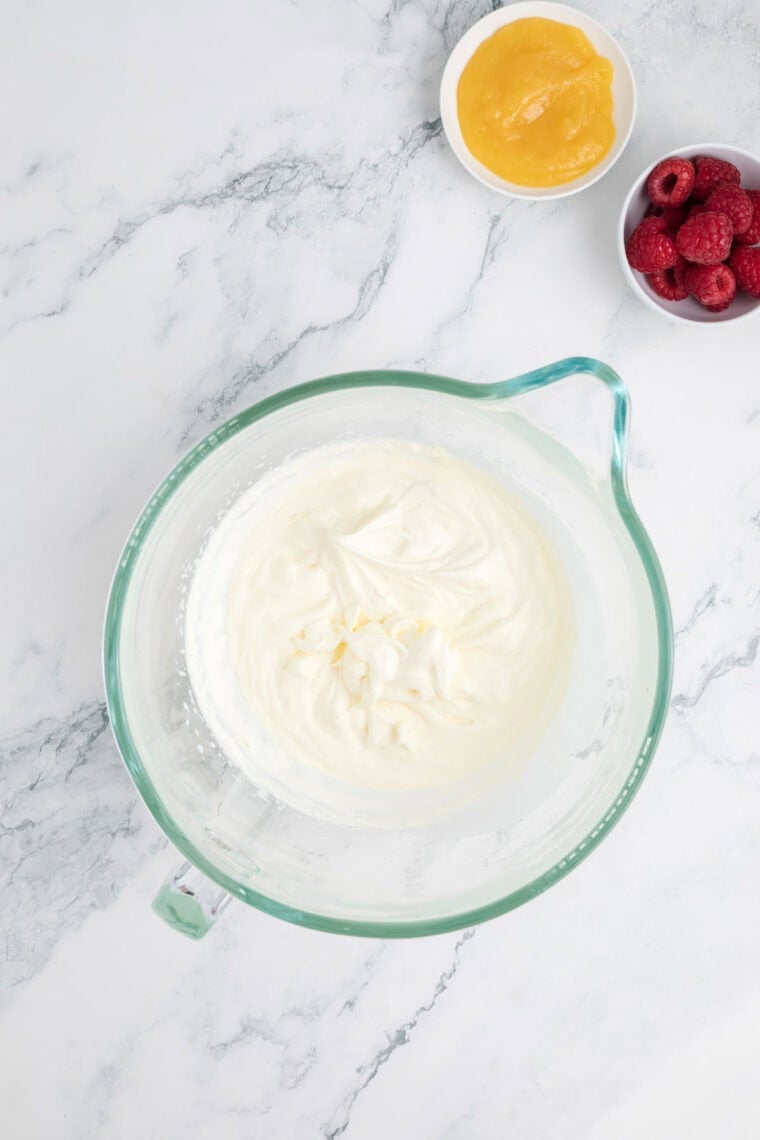
- Start assembling. Place the cooled pavlova on a serving plate.
- Add lemon curd. Top the pavlova with the lemon curd.
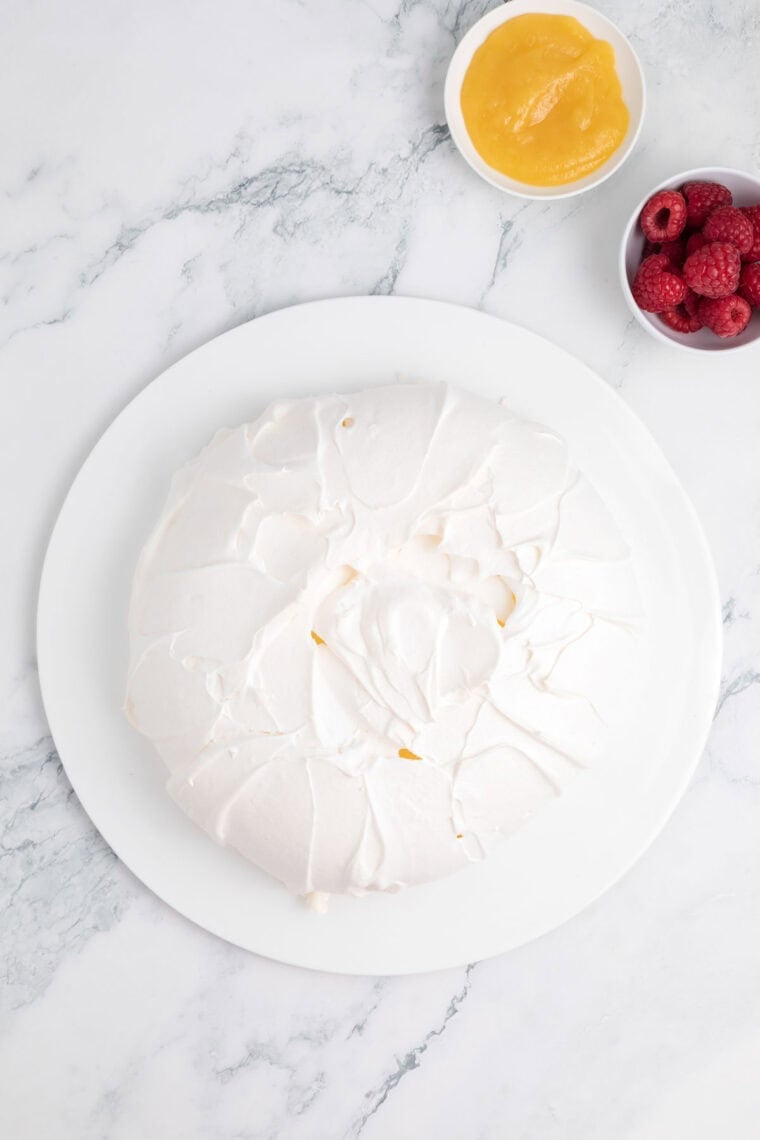
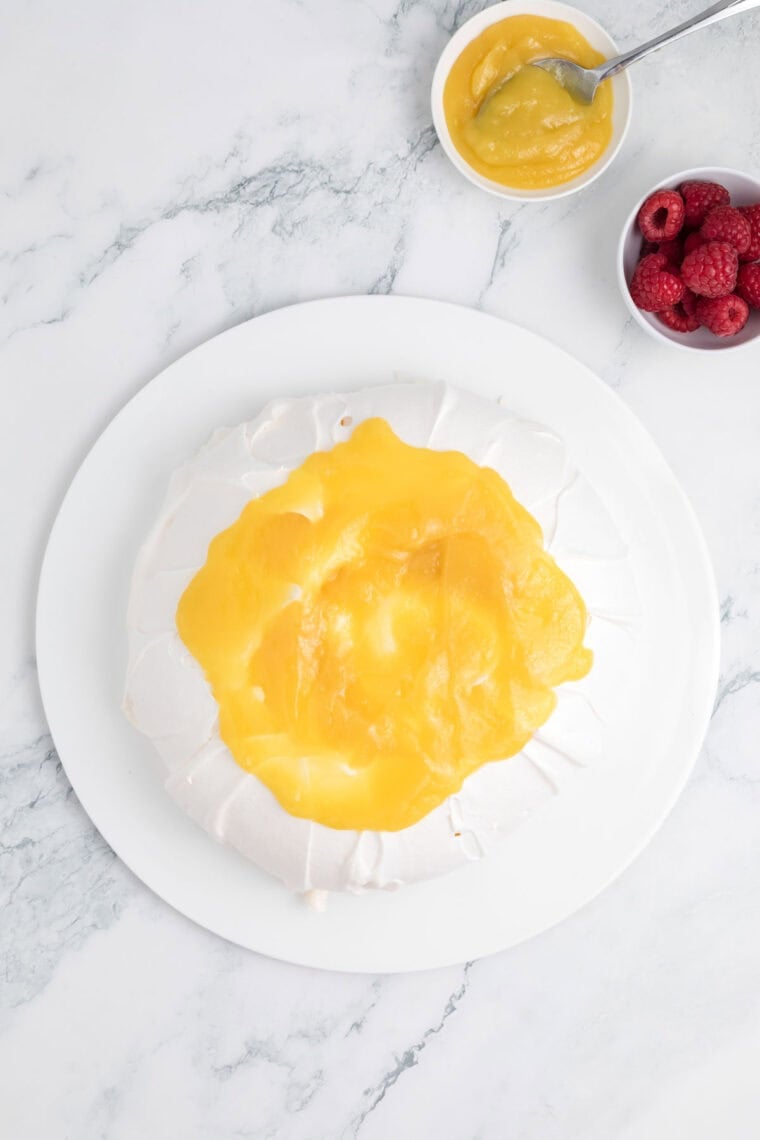
- Add whipped cream. Then, top it with whipped cream and raspberries.
- Garnish! Sprinkle the top with fresh mint leaves and serve immediately.
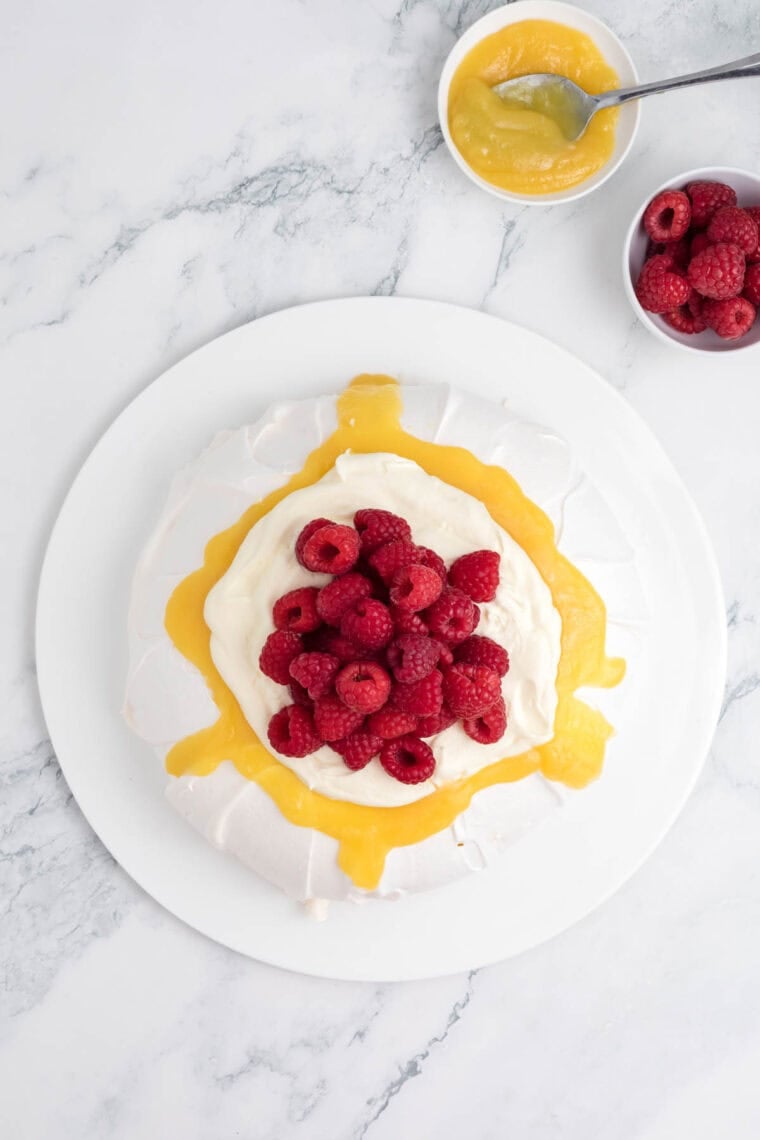
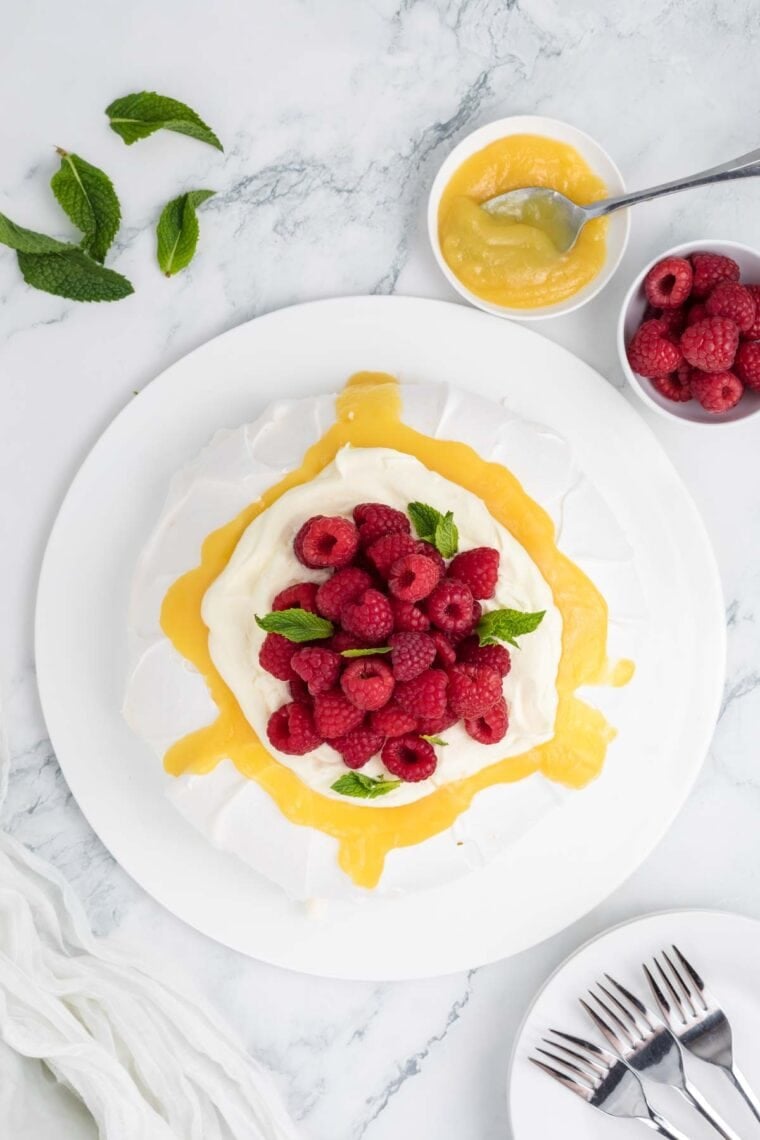
Avoiding Common Mistakes
Don’t be intimidated when you begin to make a pavlova, it’s actually easier than you would think to make it turn out well. I’ve included some troubleshooting tips below to help guide you through it:
Prevent Your Pavlova From Cracking
Try not to peek at the pavlova while it is baking, as this could cause the pavlova to collapse or crack. The key to preventing a cracked pavlova is to cook it for a longer time on lower heat. When the pavlova is set, let it cool in the oven so that it finishes cooking without cracking or falling apart.
Avoid Overbaking
A pavlova should be dry to the touch on the outside but fluffy inside—if you overbake the pavlova, you’ll end up with a hard, crunchy pavlova that no one will want to eat! Again, follow the instructions to bake the pavlova at a low temperature, then test for doneness: A perfectly baked pavlova should be pale and set, and a skewer inserted in the middle should come out with a marshmallow-like consistency.
Don’t Let It Collapse
It’s important not to over-beat the egg whites because this could cause the pavlova to collapse. Here’s a tip: Separate your eggs when they’re cold (they will separate easier). Then, let the whites come to room temperature before you beat them. This will help them increase in volume while beating. Always use fresh eggs as well as a clean, dry bowl and beaters to help the pavlova rise properly.
Getting The Perfect Texture
It’s important not to get any egg yolk in the egg whites, as the tiniest trace of egg yolk can prevent the egg whites from beating correctly. You’ll also want to make sure the sugar is fully dissolved. Check that the sugar has dissolved in the egg whites by taking a small amount of the meringue mixture and rubbing it between your fingers. Both of these steps will help achieve the perfect texture.
Can I Make It in Advance?
You can bake the pavlova up to 2 days ahead of time and store it in an airtight container in a cool, dark place until ready to serve. The pavlova is not suitable for freezing. You can store the assembled pavlova in an airtight container in the fridge for up to 24 hours, but note that its texture will begin to change. I don’t recommend assembling it ahead of time.

Other Ways to Serve Pavlova
- Berries and cream. Omit the lemon curd and pile the middle of the pavlova with lightly sweetened whipped cream and fresh berries.
- Citrus curd. Try Grapefruit Curd instead of lemon curd for a sweet-tart note.
- Chocolate sauce. Finish with a drizzle of Chocolate Glaze or Hot Fudge Sauce.
- Pastry cream. Swap the lemon curd or whipped cream for homemade pastry cream (linked above).
- Make mini pavlovas. Use this recipe to make individually sized pavlovas and serve them on pretty plates.
- In a trifle. Use a cut up pavlova in a Strawberry Shortcake Trifle!
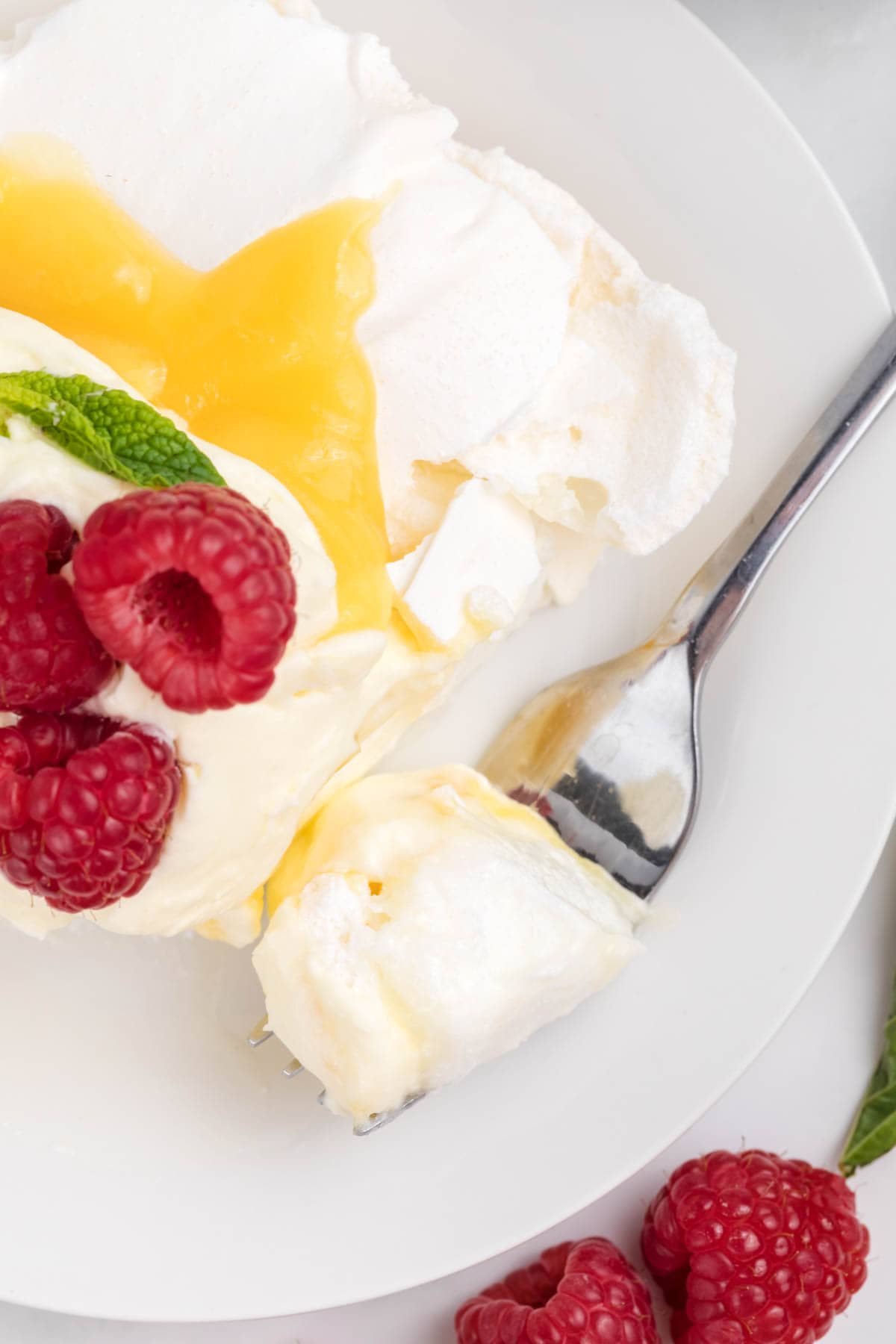
More Spring Dessert Ideas
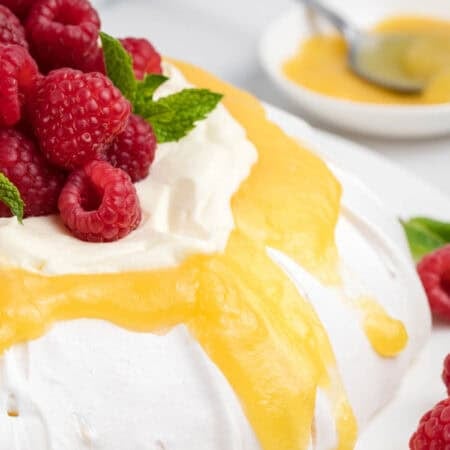
Pavlova
Ingredients
- 5 large egg whites , room temperature
- 1 ¼ cups granulated sugar
- 2 teaspoons cornstarch
- 1 teaspoon white vinegar
- 1 teaspoon vanilla extract
- 1 cup heavy cream , well chilled
- ¼ cup powdered sugar
- ¾ cup lemon curd
- fresh raspberries
- optional mint leaves for garnish
Instructions
- Preheat the oven to 250°F. Draw an approximately 10-inch circle on a sheet of parchment paper. Line a baking tray with the parchment paper and set aside.
- Add the 5 large egg whites to the bowl of a stand mixer. Beat on a medium-high speed using a wire whisk attachment until soft peaks form.
- Gradually add the 1 ¼ cups granulated sugar to the egg whites, approximately 1 Tablespoon at a time, and beat well after each addition. Continue until the meringue mixture is thick and glossy, and the sugar has dissolved.
- Add the 2 teaspoons cornstarch, 1 teaspoon white vinegar and 1 teaspoon vanilla extract to the meringue mixture, and beat until just combined.
- Using the circle as a guide, spoon the meringue mixture onto the prepared parchment paper, and shape the top and sides using a silicone spatula.
- Bake the pavlova for 1 1/2 hours. Leave the pavlova in the oven, and leave the oven door shut until the oven has cooled completely.
- To make the whipped cream, add the 1 cup heavy cream and ¼ cup powdered sugar to the clean bowl of a stand mixer. Beat on a medium-high speed using a wire whisk attachment until stiff peaks form.
- To assemble the pavlova, place the cooled pavlova on a serving plate. Top the pavlova with the ¾ cup lemon curd, followed by the whipped cream.
- Decorate with the fresh raspberries and garnish with optional mint leaves for garnish, if desired, and serve immediately.


